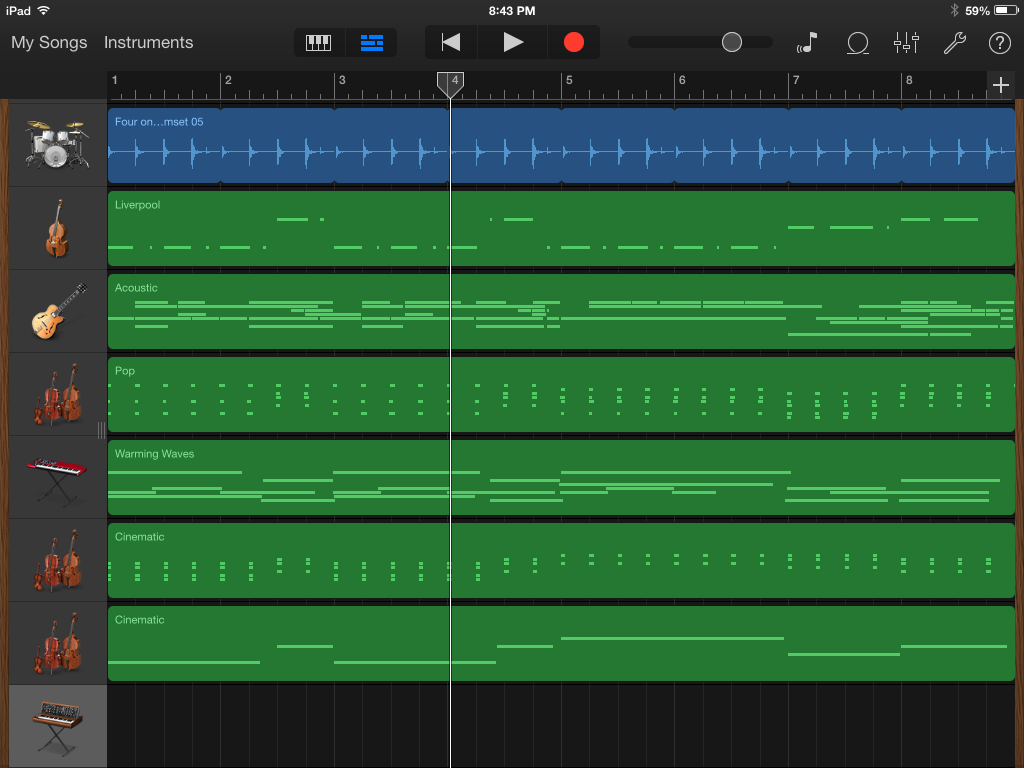GarageBand User Guide for iPad

Select the tracks you wish to join together. Again, you can do this by clicking on the tracks. The tracks will appear darker in color once selected. Combine the tracks. On the Edit menu, choose Join. You can also use the CMD-J command. This should bring the selected tracks together. Listen to the joined track.
How To Join Tracks On Garageband Ipad 4
You can merge (or bounce) any number of unmuted tracks in a song. This can be useful if you reach the maximum number of tracks for a song, but want to add more Touch Instruments.
When you merge tracks, the tracks are replaced with a single track containing a stereo audio file in a new copy of the song. The original song is available in the My Songs browser, so you can edit the original tracks.
Merge tracks
Tap a track header to select it, tap the track header again, then tap Merge.
In the track header area, tap the circles for the additional tracks you want to merge.
Tap Merge.
Merge Tracks On Garageband
A new copy of the song is created, with the merged tracks replaced by a single Audio Recorder track. The original song remains available in the My Songs browser.
You can also merge one or more tracks with the FX track. Any effects recorded to the FX track are added to the new Audio Recorder track, and the FX track is turned off (so the effects are audible only on the new track). For information about using the FX track, see Remix a song with GarageBand for iPad.
Using the GarageBand Track Editor in iLife '11, you can view the music in a region as though you're seeing it in a microscope, viewing either the actual notes in a Software Instrument track or the waveform of a Real Instrument track.
To open the Track Editor, select the track to edit and click the Editor button (the one with the scissors) in the lower left corner of the GarageBand window (or choose Control→Show Editor). The Track Editor appears below the timeline and Transport buttons and has its own Zoom slider. Depending on the type of track, you see either a note-by-note representation of a Software Instrument or the waveform of a Real Instrument.
Garageband On Ipad Pro
With both kinds of tracks, you can move the region forward (to the right) or backward (to the left) in the timeline. You can zoom in to see larger notes or a more detailed waveform by dragging the Track Editor's zoom slider in the lower left corner.
Editing Real Instrument tracks in GarageBand '11
Your performance with a Real Instrument may be slightly off the beat, but you can use the Track Editor to edit the track in one of these ways:
Move a region to adjust its location in the song. You can move a region precisely in order to line it up with the beat.
Adjust the timing with flex time. You can drag any part of the waveform to change the timing of a note or beat.
Stretch or shorten the timing of a Real Instrument performance by using flex time.Select, and then cut or copy, a section of a region and paste it into one or more locations in the song. You can cut or copy part of a Real Instrument region and paste it over another part of a region or in another place in the track.
Editing Software Instrument tracks in GarageBand '11
Software Instruments were made for the kind of editing the Track Editor enables you to do. Using the Track Editor, you can change the actual notes of a Software Instrument track (performance or loop), including the note's duration, pitch, velocity, and location in the timeline. You can also adjust the pitch and fix the timing of notes automatically.
When you open a Software Instrument region in the Track Editor, it starts out in Piano Roll view, which looks like an old-style piano roll with holes that served as instructions to a player piano. The following list describes the different ways you can edit the notes in the Track Editor's Piano Roll view:
Using Garageband Ipad
Shorten or lengthen the duration of a note: Drag the lower right corner of the note to resize it. As you drag, the note's edges snap to the lines in the beat ruler.
Change a note's starting point: Drag the note itself to the left or right, using the timeline grid as a guide.
Change a note's pitch: Drag the note up or down.
Change the note's velocity (from soft to hard): Drag the Velocity slider from left to right.
